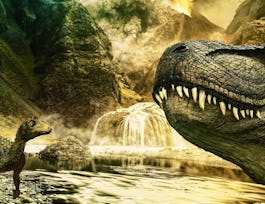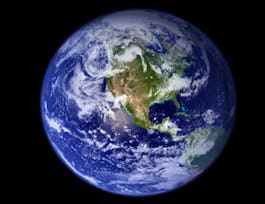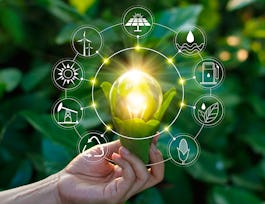Our Earth’s Future is about the science of climate change and how to talk about it. You will learn from scientists in the fields of climatology, oceanography, Earth science, and anthropology who study how climate change is affecting people, populations, and ways of life. Explore the multiple lines of evidence for the human-induced climate change that is happening today, and consider what that means for the future of our planet. At the end of this course you will be able to understand key scientific principles, identify and address misconceptions, and contribute confidently to conversations about climate change.



Our Earth's Future

Instructor: Debra Tillinger, Ph.D.
Sponsored by Taipei Medical University [C4CB]
38,181 already enrolled
(799 reviews)
Skills you'll gain
- Scientific Methods
- Environmental Policy
- Adaptability
- Natural Resource Management
- Risk Modeling
- Personal Attributes
- Mathematical Modeling
- Dealing With Ambiguity
- Environmental Issue
- Simulation and Simulation Software
- Simulations
- Systems Thinking
- Forecasting
- Environment and Resource Management
- Predictive Analytics
- Research
- General Science and Research
- Physical Science
- Predictive Modeling
- Environmental Resource Management
Details to know

Add to your LinkedIn profile
5 assignments
See how employees at top companies are mastering in-demand skills


Earn a career certificate
Add this credential to your LinkedIn profile, resume, or CV
Share it on social media and in your performance review

There are 5 modules in this course
Human-induced climate change is happening. But in order to explore the evidence for this claim, we must first ask two questions: “What is science?” and “What is climate?” Once we understand how science is done and the basic dynamics of the climate system, we’ll focus on how scientists study ice cores, and see how evidence of climate change in the past is fundamental to understanding what lies ahead.
What's included
4 videos4 readings1 assignment
Both the ocean’s sheer size – it covers seventy percent of our planet’s surface – and the properties of water make the ocean a major player in Earth’s climate system. An enormous reservoir of heat, the ocean is an important mechanism of heat storage and exchange with the atmosphere, which has important implications for climate change. We’ll focus on one of the consequences of warming: melting of the Greenland and Antarctic ice sheets. How might this melting lead to future sea level rise? Scientists are studying geological records of past warming, and associated sea level rise, to see what the future may bring.
What's included
4 videos1 reading1 assignment
An important counterpart to observational evidence is computer modeling, an essential tool for investigating how the climate system works and how it will respond to continued greenhouse gas buildup in the atmosphere. How do we know that a model is accurate? One way is to consider a past event, enter the historic climate data, and see if the model successfully “hindcasts” the event in reasonable detail. Ever more detailed, today’s supercomputer models can even help identify the potential causes of climate events on a regional scale, as climatologist Dr. Michela Biasutti explains using her research on droughts in sub-Saharan Africa.
What's included
3 videos2 readings1 assignment
Climate change is often framed as a future phenomenon, but it’s clear that people are already experiencing the consequences. What are the effects? It depends to some extent on where, and how, you live. For example, in the Pacific Islands, where sea level rise is threatening entire ways of life, communities have come together to prepare. What happens when there’s no place to go? Coastal communities aren’t the only ones at risk; food insecurity may one day threaten us all. And of course, humans are not the only species affected, and some will be at even greater risk in the future.
What's included
5 videos2 readings1 assignment
What happens next? We don’t know, but the answer depends far less on scientific data than on human action—or inaction. The major uncertainty is the future rate of greenhouse gas emissions, which is impossible to predict because it depends on socioeconomic, technological, and political developments. Furthermore, the risks posed by different kinds of natural phenomena vary widely, and similar events can have very different consequences depending on where and even when they occur. How will the effects be distributed, and how resilient are we? Hurricane Sandy provided lessons about our willingness to accept and plan for a future where severe climate events happen more frequently.
What's included
3 videos6 readings1 assignment
Instructor

Offered by
Why people choose Coursera for their career




Learner reviews
799 reviews
- 5 stars
75.12%
- 4 stars
20.25%
- 3 stars
3.12%
- 2 stars
1%
- 1 star
0.50%
Showing 3 of 799
Reviewed on Sep 19, 2020
Eye-opener!! A very informative course. Such a big help in understanding a lot about the relationship of the Earth with Climate change.
Reviewed on Sep 11, 2020
Thank you so much for sharring this valuable subject. I will be able to talk and eduacte studients that I get to teach in my clases and in my natural tours in Costa Rica
Reviewed on Jun 9, 2017
Good general introduction to climate change. Does a good job of highlighting both the science behind climate change as well as its impact on human communities now and in the future.
Recommended if you're interested in Physical Science and Engineering

Emory University

Duke University

University of Illinois Urbana-Champaign

University of Michigan

Open new doors with Coursera Plus
Unlimited access to 10,000+ world-class courses, hands-on projects, and job-ready certificate programs - all included in your subscription
Advance your career with an online degree
Earn a degree from world-class universities - 100% online
Join over 3,400 global companies that choose Coursera for Business
Upskill your employees to excel in the digital economy

